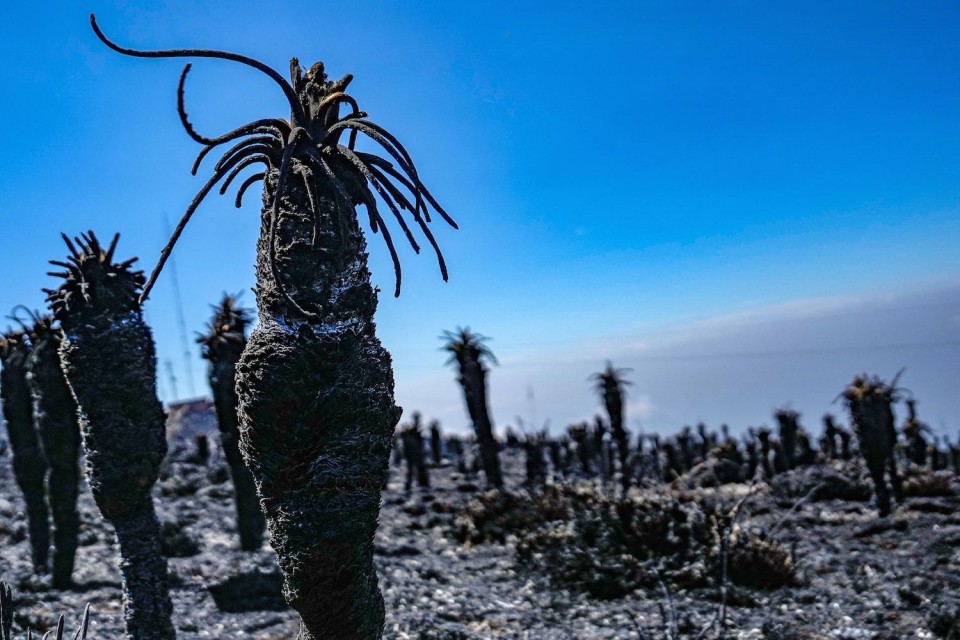
By Alejandro Rincon
BOGOTÁ, Jan 26, 2024 (AFP) – Colombia appealed on Thursday for international aid as it battled dozens of forest fires burning vast swathes of the country and encroaching on homes in the capital.
For four consecutive days, hundreds of firefighters and volunteers have fought the inferno tearing through the forested mountains above Bogota, some armed with little more than water bottles and face masks.
The fires have blanketed the capital in smoke, prompting the scrapping of in-person classes in the worst-affected areas and the delay or cancellation of dozens of flights from the El Dorado international airport due to poor visibility.
Hundreds of blazes have already been extinguished countrywide in recent weeks amid record temperatures and dry conditions linked to the El Nino weather phenomenon.
More than 6,600 hectares (16,300 acres) of vegetation have been destroyed so far, according to the National Disaster Risk Management Unit (UNGRD).
Thirty-one fires were still raging in five regions on Thursday — four of them around Bogota.
President Gustavo Petro said he had ordered the “activation of international aid protocols,” and announced offers of help from the United States, Chile, Peru and Canada.
The president has declared a natural disaster, allowing funds to be diverted from other budget items towards containing the blazes.
In the departments of Santander and Cundinamarca — of which Bogota is the capital — fires have consumed about 600 hectares of forest, officials said.
One blaze on the eastern outskirts of Bogota has shifted towards the El Cable neighbourhood, prompting officials to consider an evacuation order.
“The winds have brought it closer, but it’s still more than 900 meters (3,000 feet) from the houses,” said Bogota Mayor Carlos Fernando Galan. “If necessary, we will take evacuation measures.”
“The coming weeks will be difficult. Today we saw a few clouds, but we still don’t see any possibility of precipitation,” he added.
– ‘Maximum risk’ –
Around 87 percent of the country is considered at “maximum risk”, according to the Institute of Hydrology, Meteorology and Environmental Studies (IDEAM).
Authorities have warned of a “significant deterioration” in air quality in the city of eight million people, with Bogotans counseled against outdoor exercise.
Many pedestrians were spotted wearing facemasks.
“It really smells like smoke. You can even feel it going down your throat,” Blanca Galindo, a 69-year-old street vendor, told AFP from the foot of the mountains.
The city council advised people to close their windows and leave wet towels under their doors, and Mayor Galan said he was in touch with the Spanish ambassador regarding possible assistance as the situation “can become more critical.”
Hundreds of wild animals including raccoon-like mammals called coatis, porcupines, birds and frogs have been fleeing the heat and flames in one of the world’s most biodiverse countries.
Images shared by Colombia’s Civil Aviation Authority showed a dense white smoke cloud engulfing the control tower at El Dorado, where airport officials said 48 flights were cancelled Thursday, 16 deviated to other airports and many others delayed.
Helicopters and drones frantically buzzed back and forth above Bogota, with the president saying “all of our aircraft” have been deployed to try to snuff out the flames.
“Today, we are carrying out the largest relief helicopter operation in the history of our country,” Petro said on Thursday.
– ‘Hottest January’ –
The president said global warming was aggravating the effects of El Nino — a phenomenon typically associated with increased temperatures worldwide, drought in some parts of the world and heavy rains in others.
Forecasters expect the conditions, which began in November, to last until at least April.
“At the moment there are 62 municipalities with water stress. That is, where the freshwater capacity has equaled or is below the population’s demand,” Petro said.
Nine towns in the north, center and east of Colombia posted record temperatures this week of up to 40.4 degrees Celsius (105 Fahrenheit) in what is typically the coldest month.
“It is shaping up to be hotest January within the data we have collected,” said Ghisliane Echeverry, director of IDEAM, which has been keeping temperature records for three decades.
More than 600 firefighters, along with soldiers, police officers and volunteers are racing to battle the fires.
In the sloping hills bordering the sprawling capital, they used hoes, rakes and machetes to create firebreaks.
Soldier Gustavo Andres Betancourt described challenging conditions.
“Some hotspots are still active. They are being contained, but at night, due to the high altitude and the winds, they start up again, creating new fires,” he said.







